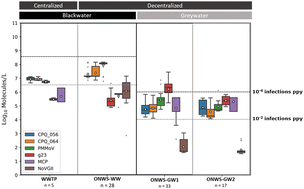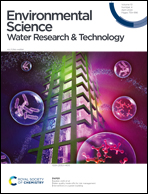Evaluating endogenous viral targets as potential treatment monitoring surrogates for onsite non-potable water reuse†
Abstract
Onsite non-potable water reuse systems (ONWS) are decentralized systems that treat and repurpose locally collected waters (e.g. greywater or combined wastewater) for uses such as irrigation and flushing toilets. To ensure that treatment is meeting risk benchmarks, it is necessary to monitor the efficacy of pathogen removal. However, accurate assessment of pathogen reduction is hampered by their sporadic and low occurrence rates in source waters and concentrations in treated water that are generally below measurement detection limits. An alternative metric for evaluation of onsite water treatment is log reduction of a more abundant organism that can serve as a surrogate for the pathogen removal. Viruses endogenous to the decentralized system could serve as monitoring surrogates to verify that treatment meets the relevant viral log reduction targets. This study assesses eight candidate PCR targets representing potential monitoring surrogates from different viral classes to determine whether they could be used to verify the efficacy of treatment in onsite non-potable water reuse systems. Candidates tested include markers for Carjivirus (formerly CrAssphage), Pepper Mild Mottle Virus (PMMoV), Microviridae, and T4 Coliphage. We quantified these targets in untreated influent wastewater at three onsite non-potable water reuse systems, two that use greywater and one that uses combined wastewater. We also confirmed, using amplicon sequencing, that the widely used Carjivirus and PMMoV primers correctly target their respective regions of interest, and found sequence diversity within the amplicons including in the probe binding region. Ultimately, we found that the surrogates assessed are not abundant enough for end uses with higher exposure use and concomitant greater removal requirements (e.g., indoor non-potable uses), but may be effective for end uses where exposure risk is lower (e.g., irrigation).



 Please wait while we load your content...
Please wait while we load your content...